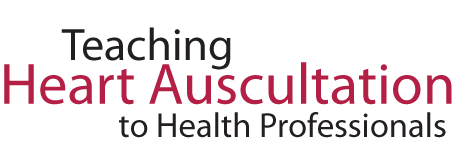Preface to 2019 Online Edition
John P. Finley MD CM
Dalhousie University
Halifax, Nova Scotia
Since publication of the 2011 print edition and the open access 2015 online version (including heart sound recordings), reception of the book and associated material has been gratifying. International access to the website has been steady and a number of Canadian and international medical schools use the recordings for group and individual teaching. With the 200th anniversary of the invention of the stethoscope by Laennec in 2016 there has been a renewed focus on physical examination. A number of articles have appeared strongly urging better teaching and emphasizing the importance of careful examination before imaging. New teaching resources and apps for mobile devices continue to proliferate, although many are not field tested before marketing. Finally the availability and promotion of inexpensive cardiac ultrasound devices has led to their widespread use, often without evidence based recommendations.
In this revised online edition much has been added or updated. In Chapter 6 the conclusions of the Canadian-Australian study on heart murmur recognition have been added, with a late reinforcement module which is available through the website. Chapter 8 on technical aspects of teaching is completely revised to reflect web-based teaching using recordings accessed on this website. Similarly Chapter 10 on curricula and Chapter 12 on teaching devices have been updated. The potential of hand held ultrasound in teaching is reviewed in Chapter 2.
Book Preface (2011)
Why a book on teaching heart auscultation in 2011? The concept of this book has been formulated gradually over my teaching career of over 30 years, prodded by the questions and provocative ideas of colleagues, in particular Dr Doug Roy. His chapter sets a challenging tone for the book, encouraging teachers to explore ways to resurrect the ancient but critically important skill of heart auscultation.
But surely the skill is now redundant with our plethora of truly remarkable imaging techniques for the heart? In reality, despite the undeniable advances in technology, heart auscultation remains one of the most important skills for health professionals for the detection of heart disease. The findings on auscultation may lead directly to a diagnosis in some cases or indicate the need for further diagnostic tests in others, but are often the first step towards diagnosis of suspected heart problems. Despite the importance of this skill, auscultation is remarkably poorly performed by medical students and practicing physicians, according to many recent studies. While most physicians carry a stethoscope, it is doubtful whether most of them could reliably distinguish pathological from normal heart sounds, especially in children. The poor performance with the stethoscope means that many patients are referred for expensive and time consuming investigations unnecessarily, while other patients who have true pathology may not be referred in timely fashion.
A major reason for poor auscultation skill is that teaching methods have changed little in the last 50 years. Medical schools generally do not employ modern protocols for teaching auditory skills, such as those validated by audiologists and neuropsychologists. There is a dearth of knowledge available to health professional schools about effective methods and technology for teaching heart sounds auscultation. Further, outcomes are rarely measured. In this book we aim to rectify the lack of information on teaching methods and promote better teaching of this skill, to equip health professionals with adequate skills to better serve their patients. The book has both an international and interdisciplinary range of contributions.
After a provocative introduction by Doug Roy and a review of the current state of auscultation by Andrew Mackie, Michael Barrett and Janice Pieretti offer their experience with a truly evidence- based approach to a new format of teaching. Repetition is emphasized, and the medium for their program is the internet. Rachel Caissie, a clinical audiologist, describes another new approach, adapting auditory training protocols which are in daily use for the hearing impaired. Auscultation teaching may have much to learn from music education. Rob Ellis provides background to how music is processed by the brain, with the implication that learning to recognize heart sounds may follow the same pathways. Thus heart sounds teaching might be informed by our understanding of the way in which music is learned.
Nancy ONeill, a neonatal nurse practitioner and educator, reminds us that it is not only physicians who require auscultation teaching. Nurses and other health professionals also require good teaching methods. A vital and unique technical chapter is provided by Brian Hoyt who brings many years of experience helping clinical teachers to record and reproduce heart sounds in an effective format, whether in class or online.
Assessment of auscultation skills is vital to learning and verifying competence. I have summarized current understanding of good assessment practice, offering advice based on my experience as well. A modern approach for auscultation teaching for health professionals is proposed to guide institutions in renovating their teaching. Finally, I have compiled a list of available teaching materials and equipment to help those searching for effective learning aids.
We are firm in our conviction that heart auscultation should not die and that the stethoscope is not just a totem or another piece of jewellery. We owe it to our patients to listen with skill to their hearts. We trust this book is a step in that direction.
April 2011


